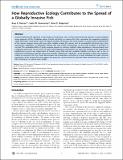Files in this item
How reproductive ecology contributes to the spread of a globally invasive fish
Item metadata
| dc.contributor.author | Deacon, Amy E. | |
| dc.contributor.author | Ramnarine, Indar W. | |
| dc.contributor.author | Magurran, Anne E. | |
| dc.date.accessioned | 2012-07-23T13:31:03Z | |
| dc.date.available | 2012-07-23T13:31:03Z | |
| dc.date.issued | 2011-09-19 | |
| dc.identifier | 15507202 | |
| dc.identifier | d5f5199d-e1a3-4475-ad52-92b7753dd85a | |
| dc.identifier | 000295257900014 | |
| dc.identifier | 80052898725 | |
| dc.identifier.citation | Deacon , A E , Ramnarine , I W & Magurran , A E 2011 , ' How reproductive ecology contributes to the spread of a globally invasive fish ' , PLoS One , vol. 6 , no. 9 , e24416 . https://doi.org/10.1371/journal.pone.0024416 | en |
| dc.identifier.issn | 1932-6203 | |
| dc.identifier.other | ORCID: /0000-0002-0036-2795/work/43550222 | |
| dc.identifier.uri | https://hdl.handle.net/10023/3006 | |
| dc.description | The work was funded by Natural Environment Research Council (NERC) (UK) and the European Research Council. | en |
| dc.description.abstract | Invasive freshwater fish represent a major threat to biodiversity. Here, we first demonstrate the dramatic, human-mediated range expansion of the Trinidadian guppy (Poecilia reticulata), an invasive fish with a reputation for negatively impacting native freshwater communities. Next, we explore possible mechanisms that might explain successful global establishment of this species. Guppies, along with some other notable invasive fish species such as mosquitofish (Gambusia spp.), have reproductive adaptations to ephemeral habitats that may enable introductions of very small numbers of founders to succeed. The remarkable ability of single pregnant guppies to routinely establish viable populations is demonstrated using a replicated mesocosm set up. In 86% of cases, these populations persisted for two years (the duration of the experiment). Establishment success was independent of founder origin (high and low predation habitats), and there was no loss of behavioural performance amongst mesocosm juveniles. Behavioural "signatures" of the founding locality were, however, evident in mesocosm fish. Our results demonstrate that introductions consisting of a single individual can lead to thriving populations of this invasive fish and suggest that particular caution should be exercised when introducing this species, or other livebearers, to natural water bodies. | |
| dc.format.extent | 8 | |
| dc.format.extent | 319790 | |
| dc.language.iso | eng | |
| dc.relation.ispartof | PLoS One | en |
| dc.subject | Guppies poecilia-reticulata | en |
| dc.subject | Genetic diversity | en |
| dc.subject | Population bottlenecks | en |
| dc.subject | Biological invasions | en |
| dc.subject | Schooling behavior | en |
| dc.subject | Larvivorous fish | en |
| dc.subject | Climate-change | en |
| dc.subject | Aquarium fish | en |
| dc.subject | Water | en |
| dc.subject | Evolution | en |
| dc.subject | QH301 Biology | en |
| dc.subject | SDG 13 - Climate Action | en |
| dc.subject | SDG 15 - Life on Land | en |
| dc.subject.lcc | QH301 | en |
| dc.title | How reproductive ecology contributes to the spread of a globally invasive fish | en |
| dc.type | Journal article | en |
| dc.contributor.institution | University of St Andrews. School of Biology | en |
| dc.contributor.institution | University of St Andrews. Scottish Oceans Institute | en |
| dc.contributor.institution | University of St Andrews. Centre for Research into Ecological & Environmental Modelling | en |
| dc.contributor.institution | University of St Andrews. Institute of Behavioural and Neural Sciences | en |
| dc.contributor.institution | University of St Andrews. Fish Behaviour and Biodiversity Research Group | en |
| dc.contributor.institution | University of St Andrews. St Andrews Sustainability Institute | en |
| dc.contributor.institution | University of St Andrews. Marine Alliance for Science & Technology Scotland | en |
| dc.contributor.institution | University of St Andrews. Centre for Biological Diversity | en |
| dc.identifier.doi | https://doi.org/10.1371/journal.pone.0024416 | |
| dc.description.status | Peer reviewed | en |
This item appears in the following Collection(s)
Items in the St Andrews Research Repository are protected by copyright, with all rights reserved, unless otherwise indicated.

